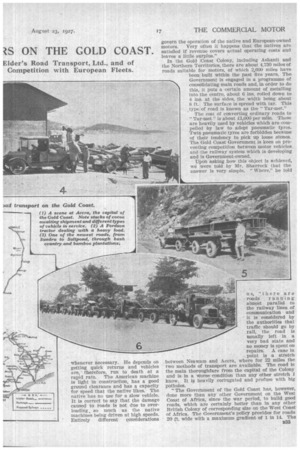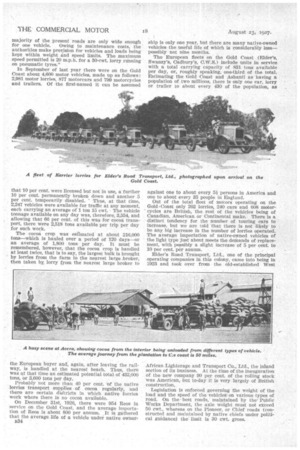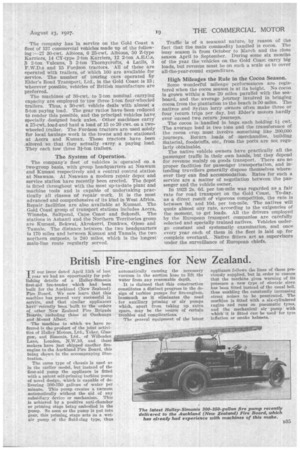OPERATING BUSINESS MC ZS ON THE GOLD COAST.
Page 50

Page 51

Page 52

Page 53

If you've noticed an error in this article please click here to report it so we can fix it.
Illuminating Details of the Activiti( Local Conditions of Operation. T. Elder's Road Transport, Ltd., and of Competition with European Fleets.
MORE than any other instrument of transport the motor lorry has facilitated the commercial productivity of the Gold Coast Colony, the enormously
rich potentialities of which are now being effectively tapped by systematically operated road services which penetrate nearly 400 miles into the interior. The Gold Coast exports over 50 per cent, of the world's consumption of cocoa, and some idea of the rapidity of the growth of this country's trade may be gauged from the fact that whereas in 1914 52,000 tons of cocoa were exported, the figure for 1926 was 230,000 tons. There are approximately 400 miles of railway open to traffic and extensions are in progress to add another 100 miles.
The development of mechanical road transport on the Gold Coast is of comparatively recent date, and since the war the number of vehicles imported yearly has increased considerably, but it is a matter for regret that the percentage of British vehicles is not higher. Roads on the Gold Coast are entirely different from those in this country, but they are serviceable and the trunk roads are being improved day by day. Operating conditions are e.xtraorclinarily difficult, for the reason that, whilst there are organized road transport services,, such as those for which Elder's Road Transport, Ltd., and F. and A. Swanzy, Ltd., in their individual capacities, are responsible. there is an enormous
number of owner-driven vehicles operated competitively with the European fleets by the native population.
In some instances the Syrian and native owners control in o P than one vehicle and machines are worked as a family concern. The overhead charges are,
therefore, kept down to a minimum and, very often, are non-existent. Thus, the natives can undertake haulage at cheaper rates than the large undertakings, but whether they give the same good transport service is quite another matter. Over 90 per cent. of the vehicles sold on the Gold Coast to-day are of American manufacture, acquired on the hire purchase system, and we have good authority for saying that this market absorbs approximately 1,300 motor vehicles (excluding motorcycles) per annum.
"It is disappointing to find that the British motor J332
manufacturer has not until recently put forward a lorry of light capacity, such as would appeal to the native operator on the Gold Coast," said Mr. Kenneth Sharrock, of Elder's Road Transport, Ltd., recently to a representative of The Commercial Motor. "Of course the native will not put his hand in his pocket to pay a heavy
price for a vehicle. His idea is to pay as little as possible and to scrap
govern the operation of the native and European-owned motors. Very often it happens that the natives are satisfied if revenue covers actual operating costs and leaves a little surplus."
In the Gold Coast Colony, including Ashanti and the Northern Territories, there are about 4,730 miles of roads suitable for motors, of which 2,600 miles have been built within the past five years. The Government is engaged in a programme of consolidating main roads and, in order to do this, it puts a certain amount of metalling into the centre, about 6 ins, rolled down to 4 ins, at the sides, the width being about 8 ft. The surface is spread with tar. This ,type of road is known as the "Tar-met."
The cost of converting ordinary roads to " Tar-met " is about 11,000 per mile. These are heavily used by vehicles which are compelled by law to adopt pneumatic tyres. Twin pneumatic tyres are forbidden because of their tendency to pick up loose stones. The Gold Coast Government is keen on preventing competition between motor vehicles and the railway system which is developing and is Government-owned.
Upon asking how this object is achieved, we were told by Mr. Sharrock that the answer is very simple. "Where," he told
whenever necessary. He depends on getting quick returns and vehicles are, therefore, run to death at a rapid rate. The American machine is light in construction, has a good ground clearance and has a capacity for speed that the native likes. The native has no use for a slow vehicle. It is correct to say that the damage caused to roads is not due to overloading, so much as the native machines being driven at high speeds. Entirely different considerations
point is a stretch between Nsawarn and Accra, where for 22 miles the two methods of transport are available. The road is the main thoroughfare from the capital of the Colony and is in a worse condition than any other stretch know. It is heavily corrugated and profuse with big potholes.
"The Government of the Gold Coast has, however, done more than any other Government on the West Coast of Africa, since the war period, to build good roads, which are certainly better than in any other British Colony of corresponding size on the West Coast of Africa. The Government's policy provides for roads 20 ft. wide with a maximum gradient of 1 in 14. The majority of the present roads are only wide enough for one vehicle. Owing to maintenance costs, the authorities make provision for vehicles and loads being kept within weight and speed limits. The maximum speed permitted is 20 m.p.h. for a 30-cwt. lorry running on pneumatic tyres."
In September of last year there were on the Gold Coast about 4,600 motor vehicles, made up as follows: 2,981 motor lorries, 877 motorcars and 799 motorcycles and trailers. Of the first-named it can be assumed that 10 per cent. were licensed but not in use, a further 10 per cent. permanently broken down and another 5 per cent, temporarily disabled. Thus, at that time, 2,247 vehicles were available for traffic at any moment, each carrying an average of 1 ton 15 cwt. The vehicle tonnage available on any day was, therefore, 3,554, and allowing that 66 per cent, of this was for cocoa transport, there were 2,518 tons available per trip per day for such work.
The cocoa crop was estimated at about 216,000 tons—which is hauled over a period of 120 days—or an average of 1,800 tons per day. It must be remembered, however, that the cocoa crop is handled at least twice, that is to say, the largest bulk is brought by lorries from the farm to the nearest large broker, then taken by lorry from the nearest large broker to the European buyer and, again, after leaving the railway, is handled at the nearest beach. Thus, there was at that time an estimated potential total of 432,000 tons, or 3,600 tons per day.
Probably not more than 40 per cent. of the native lorries transport supplies of cocoa regularly, and there are certain clis'tricits in Which native lorries work where there is no cocoa available.
On December 31st, 1926, there were 954 Reos in service on the Gold Coast, and the average importation of Reos is about 800 per annum. It is gathered that the average life of a vehicle under native owner B34 ship is only one year, but there are many native-owned vehicles the useful life of which is considerably less— possibly not nine months.
The European fleets on the Gold Coast (Elder's, Swanzy's, Cadbury's, C.W.S.) include units in service with a total carrying capacity of 831 tons available per day, or, roughly speaking, one-third of the total. Estimating the Gold Coast and Ashanti as having a population of two millions, there is only one ear, lorry or trailer to about every 430 of the population, as against one to about every 51 persons in America and one to about every 35 people hi England.
Out of the total fleet of motors operating on the Gold •Coast only 202 lorries, 240 cars and 608 motorcycles are British, the rest of the vehicles being of Canadian, American or Continental make. There is a distinct tendency for the number of touring cars to increase, but we are cold that there is not likely to be any big increase in the number of lorries operated. The average importation of native-owned vehicles of the light type just about meets the demands of replacement, with possibly a slight increase of 5 per cent. to 10 per cent. per annum.
Elder's Road Transport, Ltd., one of the principal operating companies in this colony, came into being in 1923 and took over from the old-established West African Lighterage and Transport Co., Ltd., the inland section of its business. At the time of the inauguration of the new company 99 per cent, of the rolling stock was American, but to-day it is very largely of British construction.
Legislation is enforced governing the weight of the load and the speed of the vehicles on various types of road. On the best roads, maintained by the Public Works Department, the axle weight must not exceed 50 cwt., whereas on the Pioneer, or Chief roads (constructed and maintained by native chiefs under political guidance) the limit is 30 cwt. gross.
The company has in service on the Gold Coast a fleet of 137 commercial vehicles made up of the following :-27 30-cwt. Albions, 6 25-cwt. Albions, 50 Z-type Karriers, 14 CY-type 2-ton Karriers, 12 2-ton A.E.C.s, 3 2-ton Vulcans, 3 2-ton Thornycrofts, 4 Laills, 3 P.W.D.s and 15 Fordson tractors. All of these are operated with trailers, of which 160 are available for service. The number of touring ears operated By Elder's Road Transport, Ltd., in the Gold Coast is 13; Wherever possible, vehicles of British manufacture are preferred.
The machines of 30-cwt. to 2-ton nominal carrying capacity are employed to towthree 1-ton four-wheeled trailers. Thus, a 30-cwt. vehicle deals with almost a 5-ton paying load. The gear ratios have been reduced to render this possible, and the principal vehicles have specially, designed back axles. Other machines carry a 25-cwt. load, and haul a load of 15 to 20 cwt. on a twowheeled trailer. The Fordson tractors are used solely for local haulage work in the towns and are stationed at Accra and Kumax. These tractors have been altered so that they actually, carry a paying load. They each tow three 3k-ton trailers.
The System of Operation.
The company's fleet of vehicles is operated on a two-group basis, with group headquarters at Nsawam and Kumasi respectively and a central control station at Nsawam. At Nsawam a, modern repair depot and service station have recently been erected. The depot is fitted throughout with the most up-to-date plant and machine tools and is capable of undertaking practically all classes of repair work. It is the most advanced and comprehensive of its kind in West Africa. Repair facilities are also available at Kumasi. The Gold Coast group of transport stations includes Accra, Winneba, Saltpond, Cape Coast and Sekondi. The stations in Ashanti and the Northern Territories group are Kumasi, Bekwai, Akrokerri, Dunkwa, Ojeso and Tamale. The distance between the two headquarters is 170 miles and between Kumasi and Tamale, the two northern outposts, is 240 miles, which is the longest. main-line route regularly served.
Traffic is of a seasonal nature, by reason of the fact that the main commodity handled is cocoa. The busy season is from October to March and the close season April to September. During some six months of the year the vehicles on the Gold Coast carry big loads, but revenue must be on such a scale as to cover all-the-year-round expenditure.
High Mileages the Rule in the Cocoa Season.
Some wonderful mileage performances are registered when the cocoa season is at its height. No cocoa is grown within a line 20 miles parallel with the seaboard, and the average journey involved in bringing cocoa from the plantation to the beach is 50 miles. The natives and Syrian lorry owners often make three or four ,return trips per day. but Elder's motors hardly ever exceed two return' journeys.
The cocoa is handled in bags, each holding 11 cwt. The average load is two tons and the transference of the cocoa crop must involve something like 200,000 journeys. Return loads of 'merchandise, building material, foodstuffs, etc., from the ports are not regularly obtainable.
The native vehicle owners have practically all the passenger traffic in their own hands, but they depend for revenue mainly on goods transport. There are no proper facilities for passenger transportation, and intending travellers g-eneriilly dispose themselves whereever they can find accommodation. Rates for such a service are a matter of negotiation between the passenger and the vehicle owner.
In 1923 2s. 6d. per ton-mile was regarded as a fair rate for road transport on the Gold Coast. To-day, as a direct result of vigorous competition, the rate is between 9d. and 10d, per ton-mile. The natives will quote almost any rate, according to the exigencies of the moment, to get loads. All the drivers employed by the European transport companies are carefully selected and specially trained natives. Vehicles undergo constant and systematic examination, and once every year each of them in the fleet is laid up for complete overhaul. Native fitters act as supervisors under the surveillance of European chiefs.




































































































